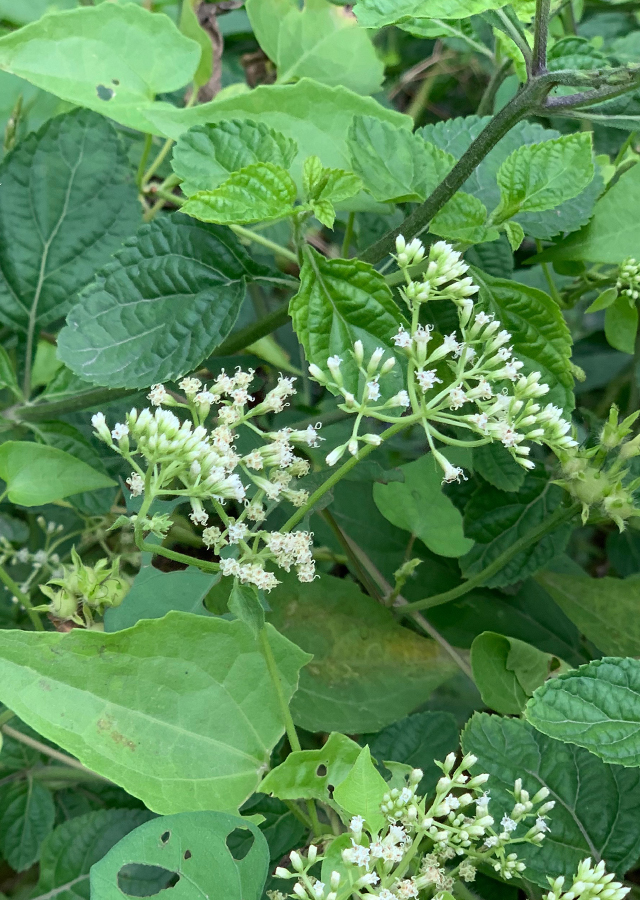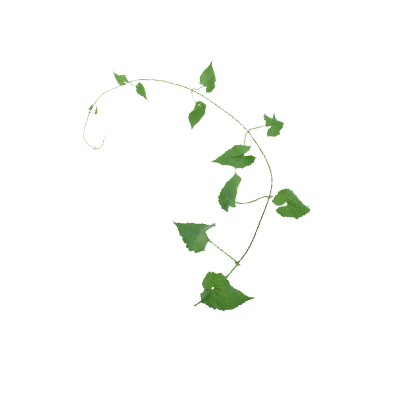Bitter Vine
Mikania micrantha Kunth
Asteraceae
Location in our garden
Principal



Synonym
Eupatorium denticulatum Vahl
Eupatorium orinocense (Kunth) M.Gomez
Eupatorium orinocense var. batatifolium M.Gomez
Habitus
Climbers. A very vigorous, climber plant, slender, reaches 3-6 m long
Part Used
Leaves
Stem
Tuber
Growing Requirements
Full Sunshine
Need Shade
Habitat
Riverbanks
Forest
Grassland
Overview
Bitter vine is native to tropical and subtropical South and Central America and the Caribbean. It is a major invasive in several parts of South-East Asia and the Pacific islands. It is also cultivated as an ornamental and ground cover plant, though because of its ability to spread as a weed these uses should be discouraged outside of the plant's native range.
Vernacular Names
Selaput tunggul (Malaysia), Oori Hingchabi (Inida), Wa bosucu (Fiji), Fue saina (Samoa) Liane-serpent (French), Guaquito (Spanish), Sembung rambat (Indonesia).
Agroecology
Tolerates some shade, growing best where fertility, organic matter, and soil and air humidities are all high. This species is widely regarded as one of the worlds worst weeds. It is a major weed in plantations, pastures and along roadsides, and is an intermediate weed in crops and forestry. It may grow at an elevation of 2,000 m or more.
Morphology
- Root - adventitious roots at their nodes.
- Stems - much branched, spreading, angular/longitudinal boned, light green to dark, branched and overgrown with fine hairs. Stems grow up to 3-6 m in length.
- Leaves - opposite, stalked, oval or triangular. The leaves are hairless. Leaf size varies from 30 x 15 mm to 125 x 60 mm. Petiole 1-6 cm in length and overgrown with fine hairs.
- Flowers - axillary, white flower crown, tubular, 4-6.5 mm wide, flower stalk 3-15 mm length. The anthers are grayish-black with white pistils.
- Fruits - plants can flower and produce fruit all year round with brown seeds.
- Seed - the tiny black seeds (1.5-2 mm long) are topped with numerous whitish-colored hairs or bristles (2-4 mm long). Each individual can produce 20,000-40,000 seeds.
Cultivation
- It is propagated by seed, germinates best in a sunny position, the optimum temperature being 25-30 °C.
- Also propagated by cutting the stems.
Chemical Constituents
Phenol, terpenoid, flavonoid.
Traditional Medicinal Uses
- The leaves are an antidote, cholagogue, diuretic febrifuge, and anti-menorrhagic.
- A tea made from the whole plant is used as a treatment for stomach aches and to clean out the uterus (dilation and curettage). It is boiled with other plants to produce a tonic that can reduce malarial fever.
- A decoction of the stem and leaves is used as a remedy for a children's clyster and to treat malaria and eczema. The stems are squeezed, mixed with ginger rhizomes (Zingiber officinale), and eaten with green vegetables as a remedy for colds, headaches, and stomach aches.
- An infusion is used for washing the skin as a treatment for rashes, skin eruptions, smallpox, chickenpox, and measles. Juice from the macerated leaves is applied to persistent sores and bush-yaws.
- An infusion is used as a remedy for snakebite and syphilis. A decoction is used for a febrifuge bath.
- The macerated leaves are vigorously rubbed on the skin as a treatment for rashes. Leaf in liquid mixture is used to treat children's anal thrush, and it is placed in a hot water bath for women after confinement for pregnancy.
- Anti-malaria agent.
Part Used
Reference Sources
- Pebriani, Linda, R, and Mukarlina. (2013). Potensi ekstrak daun sembung rambat (Mikania micrantha H.B.K) sebagai bioherbisida terhadap gulma maman ungu (Cleome rutidosperma D.C) dan rumput bahia (Paspalum notatum Flugge). Protobiont 2(2): 32-38.
- Priwiratama, H. (2011). Informasi organisme pengganggu tanaman: Mikania micrantha H.B.K. Pusat Penelitian Kelapa Sawit, Medan.
- Sitepu, W.B. (2019). Efek antimalaria fraksi n-heksana, etil asetat, dan air daun sembung rambat (Mikania micrantha Kunth) pada mencit jantan yang diinfeksi dengan Plasmodium berghei. Undergraduate Thesis. Program Studi Sarjana Farmasi, Fakultas Farmasi, Universitas Sumatera Utara, Medan.

